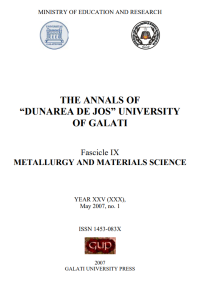Grain Refinement in Aluminum Alloys by Acoustic Cavitation Phenomena
Abstract
In this article, ultrasonic method of transmitting forced vibrations to solidifying aluminum-alloy melts is presented. In the presence of well developed cavitation situations, a fine and homogeneous microstructure has been observed throughout the irradiated ingots. The effects produced when high-intensity sonic or ultrasonic waves are propagated through molten metals can be listed under three main categories: grain refinement, dispersive effects, and degassing resulting in reduced porosity. It has been found that vibrations of a mechanical origin are effective in increasing fluidity by as much as a factor of three and consequently, favorably influence the mold-filling ability of aluminum alloys. There appear to be two distinct views regarding the mechanism, which may be explained by the cavitation effects and the influence of the fluid-flow phenomena.
Downloads
References
[2]. C. Vivès, 1989, Grain Refinement in Aluminium Alloys by Means of Electromagnetic Vibrations Including Cavitation Phenomena, Metall. Trans. B, 20B, p. 623.
[3]. C. Vivès, Metall. Trans. B, 20B (1989), p. 631.
[4]. M.C. Flemings, 1991, Metall. Trans. B, 22B, p. 269.
[5]. C. Vivès, 1992, Effect of low frequency electromagnetic field on microstructures and macrosegregation of horizontal direct chill casting aluminium alloy, Metall. Trans. B, 23B, p. 189.
[6]. C. Vivès, 1993, Grain refinement induced by electromagnetic stirring: A dendrite fragmentation criterion, Metall. Trans. B, 24B, p. 493.
[7]. J.-P. Gabathuler et al., 1992, Processing of Semi-Solid Alloys and Composites, ed. S.B. Brown and M.C. Flemings Cambridge, MA: MIT, p. 33.
[8]. O. Abramov, 1994, Ultrasound in Liquid and Solid Metals Boca Raton, FL: CRC Press, p. 289.
[9]. T. Leighton, 1994, The Acoustic Bubble, London: Academic Press Ltd, p. 531.
[10]. J. Szekely, 1979, Fluid Flow Phenomena in Metals Processing, New York: Academic Press Ltd, p. 305.
[11]. C. Vivès, (1990) Int. J. Heat Mass Transfer, 33, p. 2585.
[12]. L. Moraru, S Macuta, 2006, Acoustical degassing of molten aluminium, SISOM 2006 (Annual Symposium of the Institute of Solid Mechanics), Bucuresti, 17-20 Mai, CD-ROM publication.
[13]. C. Vivès, 1996, Effects of Forced Electromagnetic Vibrations during the Solidification of Aluminium Alloys: Part I. Solidification in the Presence of Crossed Alternating Electric Fields and Stationary Magnetic Fields, Metall. Trans. B, 27B, p. 445.
[14]. C. Vivès, 1996, Effects of Forced Electromagnetic Vibrations during the Solidification of Aluminium Alloys: Part II. Solidification in the Presence of Colinear Variable and Stationary Magnetic Fields, Metall. Trans. B, 27B, p. 456.
[15]. Abramov O.V., 1993, Ultrasound in liquid and solid metals, Russian Academy of Sciences, Moscow, (in English).
[16]. Moraru L. 2005, The effect of fluid flow on solidification of light metal alloy, Transaction of the University of Kosice, vol. 5, p. 70-75.
[17]. Moraru L., Tudose C., 2004, Analytic model of bonding forces in liquid metals and ultrasound influence, Proc 2nd Int Conf Romanian Acoustical Society, Impuls Publishing House Ed., Bucureşti, p. 75-80.



